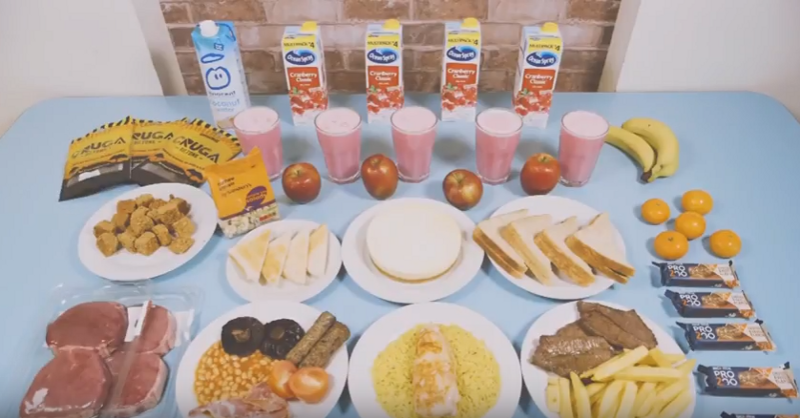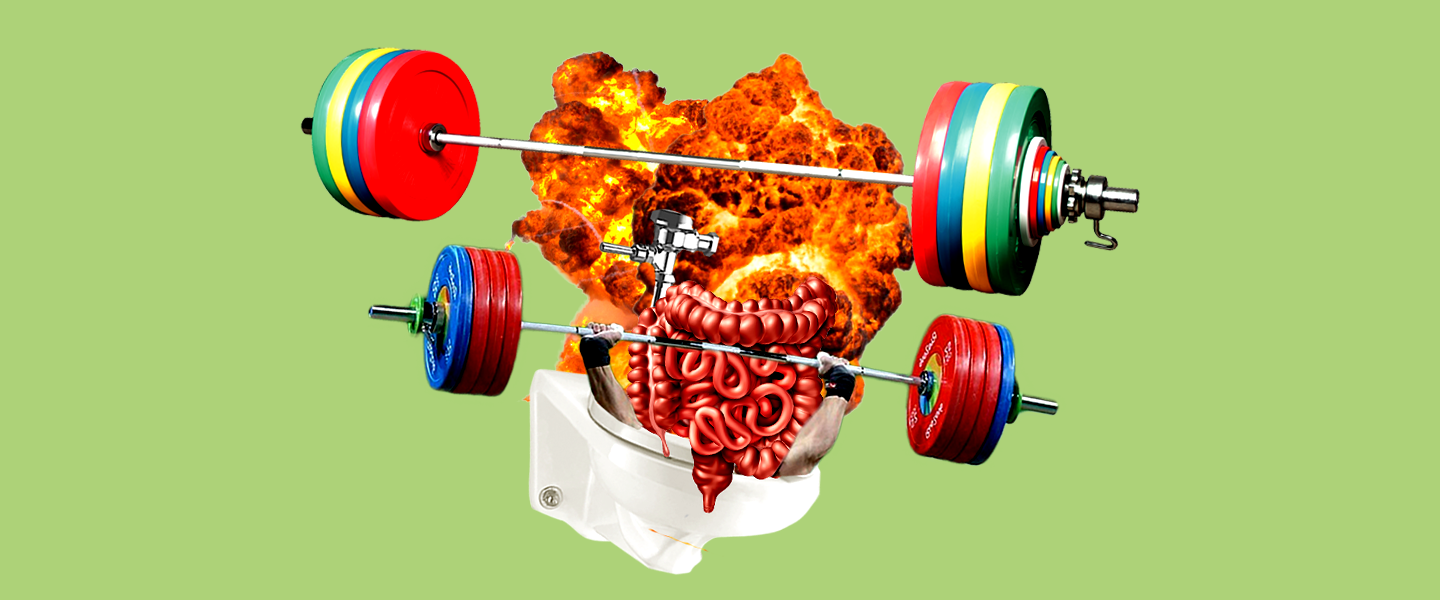For most spectators, seeing a huge dude like former World’s Strongest Man Eddie Hall waddle onstage, bend down and deadlift 1,102 pounds is enough. The size of this competitor, shaped like a beer barrel during his competitive days, probably occupies whatever thoughts you aren’t giving to the enormity of the feat he’s about to perform. The last things you’re likely thinking about are the strongman’s knuckle-sized hemorrhoids, his chronic irritable bowel syndrome or the fact that he might be wearing an adult diaper along with anal tampons to prevent the leakage of blood and feces.
It’s all, though, the competitors are thinking about — well, that and winning. “The workings of their bodies, in particular their digestive system, are always on their minds,” champion powerlifter and bodybuilder Stan Efferding tells me. “And why wouldn’t they be? For many years, reaching the size these men are has entailed extraordinary sacrifice in terms of diet and toilet time. The majority of what a strongman does is eat. In fact, for a long time, the thinking was that they had to eat all day long, clearing 12,000 calories or more — force-feeding, really.”
Two separate documentaries have tracked the life, times and diet of Hall, formerly a record-setting English swimming prospect with Olympic aspirations. Both Eddie: Strongman (2015) and Born Strong (2017) have focused on the self-made circumstances of Hall’s career, which have included spending thousands of dollars per week on food and then finding the time to eat it all.
“I get about 12,500 calories a day,” Hall explains in Born Strong. “You eat a meal every hour and a half to two hours. You set an alarm on your phone, because you’ve got to eat on the dot. I get up at 3 a.m. and eat raw steaks. I get up at 7 a.m. and have a proper English breakfast. Then I get up at 10 a.m. and have a third breakfast. Fruits, beef jerky, liters of cranberry juice, steak and chips, chicken and pasta, half a cheesecake, flapjacks — it never stops. You’ve got to be constantly grazing like a cow.”

In a 2017 video filmed for powerlifting mogul Mark Bell’s YouTube channel, Brian Shaw describes a similarly over-the-top eating regimen, walking viewers through the seven meals which he consumes daily (at around 12,000 calories in total). “Big day of eating,” he says at the end, “especially because I didn’t get to spread it out as much. I’ve been pretty hungry, but tonight I feel full and I’ll get to see how it impacts my training tomorrow. I’m not eating all this food just to eat it, but to see how my body responds to it during training.”
“That’s how Shaw and others were eating for a very long time,” says Efferding, who now provides nutritional consulting to Shaw and other strongmen and who has studied the toll this all-out approach to eating has taken on these competitors. “That’s been the strategy since the early days of the sport. But I stepped in with Shaw and Hafþór Júlíus Björnsson (aka “the Mountain”) and suggested some dietary and lifestyle changes that altered the way they moved around, the way they felt when they were just sitting around and the way they approached the bathroom.”
The first order of business for men in the 300-pound range, Efferding tells me, is getting them to start using a high-quality continuous positive airway pressure ventilator, commonly referred to as a “CPAP.” “Anyone who weighs over 250 pounds and has issues with neck girth should be using a CPAP. It’s dangerous not to do so,” he explains. “Many of these big men find themselves gasping for air, essentially choking to death, so they’re not getting the high-quality sleep they need. As a trainee myself, I prioritized sleep over everything else. Some of these guys do already have CPAPs, but some don’t, and they wonder why their 10 hours of sleep aren’t resulting in a proper recovery. If you’re that big, sleep can be dangerous for you. And being big is their job. Other than retiring and losing weight, as they often do when they quit, there isn’t much else you can do there.”
Next, Efferding prioritizes making these men move around early in the workday. “We think of strongmen and super heavyweight powerlifters as amazing athletes, but what they are is amazingly specialized athletes. They can, for example, waddle under a bar and perform a heavy, deep back squat. But even athletes of this type who look somewhat fit can become easily fatigued by walking up a few steps or walking around the house. They might have big gas tanks, but they’re emptied easily. So I encourage the guys I’m consulting to take a few five- and ten-minute walks each day, and we’ve seen excellent results there. Hafþór and Shaw have gotten to where they can tackle many sets of stairs or walk for an hour or more without fatiguing, and the results are obvious in their toned-up physiques and increased speed in certain strongman events.”
But where the, um, shit really hits the fan is in the restroom. “Strongmen and powerlifters have traditionally had very bad bathroom hygiene, because they haven’t prepared properly to go to the bathroom,” Efferding explains. “They’ve been eating to lift, but not thinking about how eating affects their bowel movements. If you’ve ever eaten like a hog for an extended period of time — and by that, I mean eaten like a hog that’s being deliberately fattened up because everything is riding on its sale — you’d understand, but I’m not sure many people do. Few people have the stomach to eat like this, no pun intended. They’d give up, since nothing is at stake for them.”
Alas, I understand all too well. In 2005, I thought it would be a good idea to enter a USA Wrestling regional event in southern Indiana at the weight maximum of 130 kg (285 pounds). I’d been struggling to cut to 97–98 kilograms (roughly 214 to 216 pounds) for the previous two years, and I wondered how a vast amount of added bulk would impact my performance. The pro wrestler “Doctor” Jerry Graham had claimed that beefing up to 400 pounds late in his career had given him the “poise and balance of a sumo wrestler,” and although I knew this was nonsense, I assumed that slapping 60 more pounds on my frame in a few months would give me some sort of competitive advantage.
It didn’t.
I gained the weight and then some, weighing 300 pounds around the time of the tournament. I’d become so heavy, in fact, that I was too lethargic from eating 10,000 calories a day, mostly from grease-soaked bags of Chicago-style dogs and fries purchased at a local greasy spoon called King Gyros, to make the five-hour drive from Valparaiso, where I lived, to Evansville, where the tournament was being held.

It was an incredibly misguided journey, akin to the season of It’s Always Sunny in Philadelphia when “Fat Mac” sought to change his life by packing on mass(now the character is jacked). I could, though, relate to everything Efferding was talking about, even if it had been a long time since I’d thought about my brief stint as a 300-pounder. My sleep was restless, and my roommates could find no relief from my snoring. Meanwhile, my once-prodigious endurance was hampered by balky knees that buckled under the added mass. And my shits… well, the less said, the better.
“You have to consider the impact of eating dozens of pancakes and cheesecakes and so on in terms of your bowel movements,” Efferding says. “Cheesecake is something they all mention because it’s such a quick source of calories. But if you’re eating this way, and many of them are, you’ll develop hemorrhoids, irritable bowel syndrome, chronic diarrhea and worse. And although diet doesn’t cause Crohn’s disease, diet combined with ibuprofen-style pain relievers can worsen it.
“Some of the guys eat so much food that they’re exposed to allergens they have no idea they’re reacting to. Others are either lactose intolerant or have become lactose intolerant. So I’ve focused on creating a diet that lets them have safe, tapered bowel movements — food that lets them cross basic macro- and micro-nutrients off the list while still having a stomach that isn’t keeping them sick to the point of experiencing nausea or visiting the bathroom and experiencing bloody misery in there.”
What kind of food is this specifically? It’s pretty easy: Efferding’s big men drink a few smoothies consisting of orange juice mixed with spinach, and drink (or consume) a bunch of thermoses containing unseasoned, ground-up top sirloin mixed with steamed white rice and water. This meat-rice mush represents the pinnacle of what Efferding calls his “vertical diet.”
“As a competitor myself, I’ve already done this experimentation in terms of diet and sleep,” Efferding says. “Every minute of my life is the payoff of the logistical preparation I’ve completed days or weeks in advance. My sleep cycle is set, my diet is set and my training regimen is set. With this type of food, which is easy on the stomach, you can train your metabolism to work perfectly. You start with specific meal sizes and slowly add more ground steak and white rice to the portions. You can go all-out with the white rice, because it’s pure calories with few consequences. The spinach and juice shakes, mashed-up sweet potato and small portions of raw milk and carrot add variety and much-needed micronutrients. But the bulk of what you get is coming from ground-up steak, which is the best way to digest it since there are no sticky ends, and soft rice.”
By advocating for this simple but restrictive program, Efferding believes he’s offered a solution to the chronic bathroom problems that plague the heavy-duty strength sports. And while he recognizes that “not all athletes are going to follow something like this, athletes unwilling to make those slight adjustments in the margins will lack the extra edge they need to finish in a medal position.”
He shits you not.

